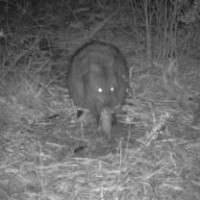A quokka with one of the baits
Native species interfering with ground distributed baits used to control red foxes in south west Western Australia may mean the baits are not available to the target species, a Murdoch University study has found.
Postdoctoral research fellow Shannon Dundas from the University's School of Veterinary and Life Sciences used cameras and regular visits to monitor seven sites ground-baited at high densities on a monthly basis over nine months.
She found that 99 per cent of camera monitored baits were taken by species other than foxes, with 95 per cent taken by native fauna and five per cent taken by introduced pigs and black rats.
Only a single monitored bait was taken by a fox – the target species of this baiting program.
"Foxes are present in the baited areas but the issue is that non-target species are consuming baits shortly after distribution, reducing the opportunities for foxes to find and consume baits," said Dr Dundas.
"Baits did not last very long in the environment, with 62 per cent of the 299 baits monitored taken on or before the first night after distribution, and 95 per cent of baits taken within seven days."'
The poison compound used in WA in fox baits (commonly known as 1080) is found naturally in native WA plant species. Dr Dundas said it is the most appropriate poison for use in WA because introduced species are more sensitive to its effects than native species.
A fox at a bait site
"Many native species in Western Australia have high tolerances to 1080 poison, so even though they may consume multiple 1080 baits, it is highly unlikely they can consume enough poison for a lethal dose," she said.
Dr Dundas added that the costs and labour associated with baiting can be substantial and called for further research into how the baits could better target foxes and reduce interference by non-target species.
"Further studies of fox behaviour and movements in baited forest areas with the use of GPS collars would provide valuable information and could help to direct baits more specifically to foxes," she said.
"Additionally, alternative approaches could be trialled, such as changing the bait presentation to make it less accessible to native species, or altering bait attractiveness or type to more specifically target foxes."
Provided by Murdoch University
























